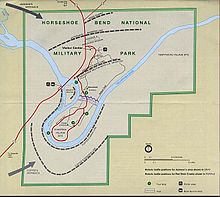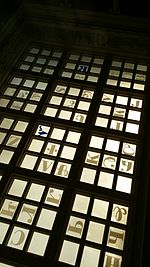Sequoyah
[4] Sequoyah's creation of the Cherokee syllabary is among the few times in recorded history that an individual member of a pre-literate group created an original, effective writing system.
It is believed to have inspired the development of 21 scripts or writing systems used in 65 languages in North America, Africa, and Asia.
James Mooney, a prominent anthropologist and historian of the Cherokee people, quoted a cousin as saying that as a little boy, Sequoyah spent his early years with his mother.
In the people's matrilineal kinship system, children were considered born into their mother's family and clan, and her male relatives were most important to their upbringing.
Historian John B. Davis says the name may have been derived from sikwa (either a hog or an opossum) and vi meaning "place, enclosure".
Davis cites Emmet Starr's 1917 book, Early History of the Cherokees, as saying that Sequoyah's father was a Virginian fur trader from Swabia named Nathaniel Guyst, Guist, or Gist.
Bird says that Sequoyah was a full-blood Cherokee who always opposed the submission and assimilation of his people into the white man's culture.
The encyclopedia noted that Bird presented no documentary evidence of his assertions, but his account has gained some credibility in academic circles.
Davis wrote that an early issue of the Cherokee Advocate said he "was the victim of a hydrarthritic trouble of the knee joint, commonly called 'white swelling'."
After a few months, he was rarely seen sober, neglecting his farm and trading business, and spending his money buying liquor by the keg.
Sequoyah came to believe that one of white people's many advantages was their written language, which allowed them to expand their knowledge, partake in many forms of media, and have a better network of communication.
In 2008, archeologist Kenneth B. Tankersley (Cherokee Nation) of the University of Cincinnati found carvings from the syllabary in a cave in southeastern Kentucky, where Sequoyah is known to have had relatives.
Many Cherokee began migrating there even before ceding their land around Sequoyah's birthplace in 1819, as they were under continual pressure by European-American settlers.
In 1813–1814, Sequoyah served as a warrior of the Cherokee Regiment, commanded by Colonel Gideon Morgan, at the Battle of Horseshoe Bend against the "Red Sticks" (Creek, or Muskogee, renegades).
Four years later, he was one of the "Old Settler" delegates that went to Washington, D.C., to sign the treaty that exchanged the Cherokee land in Arkansas for Indian Territory (modern-day Oklahoma).
In 1839, Sequoyah and the 16 other Old Settlers and about 15 representatives of the Ross party signed the Act of Union, and a new Cherokee constitution was created.
A majority of the Cherokee believed that writing was either sorcery, witchcraft, a special gift, or a pretense; Sequoyah accepted none of these explanations.
Eventually, the warriors presiding over their trial, along with the town, believed that Sequoyah had in fact created a new form of communication, and they all wanted him to teach it to them.
When Sequoyah went to the eastern tribes, he brought a sealed envelope containing a written speech from one of the Arkansas Cherokee leaders.
[15][16] In 1825, the Cherokee Nation officially adopted the writing system, making them one of the first indigenous groups to have a functional written language.
He was accompanied by his son, Teesy (Chusaleta), as well as other Cherokee men identified as Co-tes-ka, Nu-wo-ta-na, Cah-ta-ta, Co-wo-si-ti, John Elijah, and The Worm:[12] "In the summer of 1842, influenced perhaps by a desire to explore the Western prairies, and become acquainted with his Red Brethren, who roam them free and untrammlled [sic], Se-quo-yah, having loaded several pack horses with goods, visited, in company with a number of Cherokees, the Cumanche Indians.
After remaining with them some time, he made his way with a son and two or three other Cherokees, into Northern Mexico, toward Chi-hua-hua, and engaged a while in teaching the Mexicans his native language.
"Sometime between 1843 and 1845, he died due to an estimated respiratory infection during a trip to San Fernando de Rosas in Coahuila, Mexico.
A letter written in 1845 by accompanying Cherokee stated that he had died in 1843:[12] Warren's Trading House, Red River, April 21st, 1845.
We, the undersigned Cherokees, direct from the Spanish Dominions, do hereby certify that George Guess of the Cherokee Nation, Arkansas, departed this life in the town of San-fernando in the month of August, 1843, and his son Chusaleta is at this time on the Brasos River, Texas, about thirty miles above the falls, and he intends returning home this fall.
[24] In 2011, the Muskogee Phoenix published an article relating a discovery in 1903 of a gravesite in the Wichita Mountains by Hayes and Fancher, which they believed was Sequoyah's.
The two men said the site was in a cave and contained a human skeleton with one leg shorter than the other, a long-stemmed pipe, two silver medals, a flintlock rifle and an ax.
[26] Due to Sequoyah's contributions and achievements in Cherokee history, there are statues, monuments, museums, and paintings dedicated in his honor across the United States and in various genres.
In 1824, the General Council of the Eastern Cherokee awarded Sequoyah a large silver medal in honor of the syllabary.
[citation needed] People of all ages are taught the language, parents and adults, children in schools, and it is offered at several universities in Oklahoma and North Carolina.





